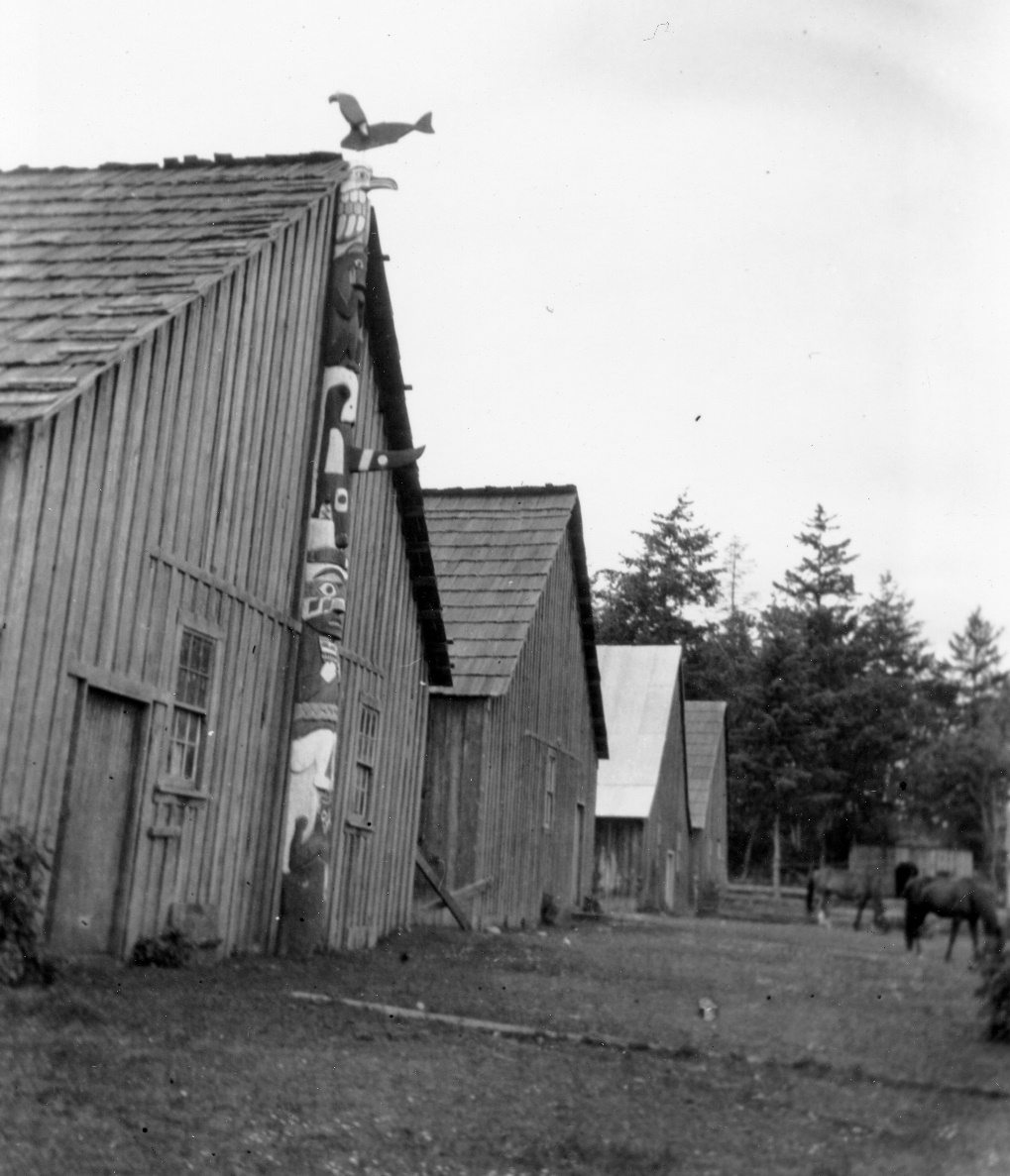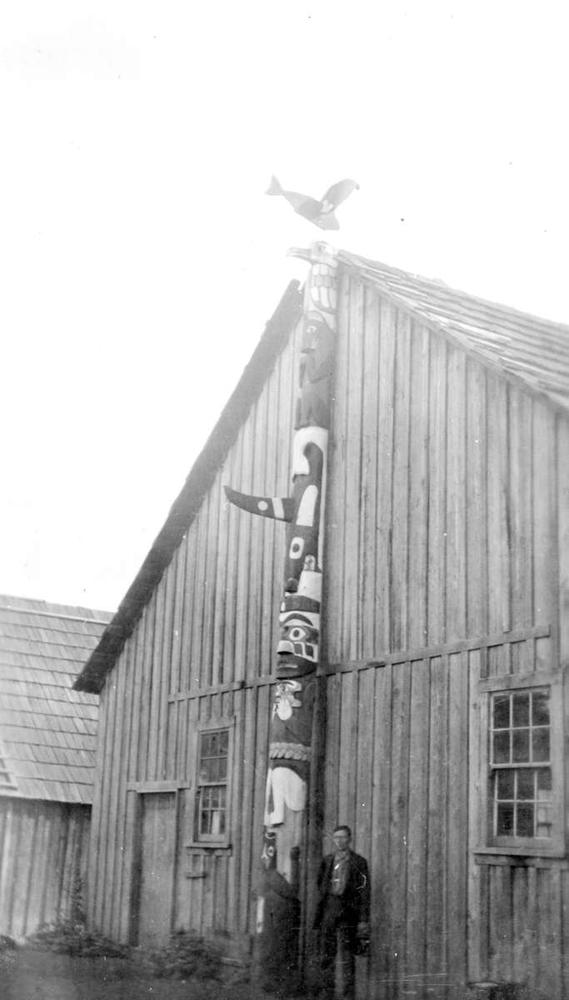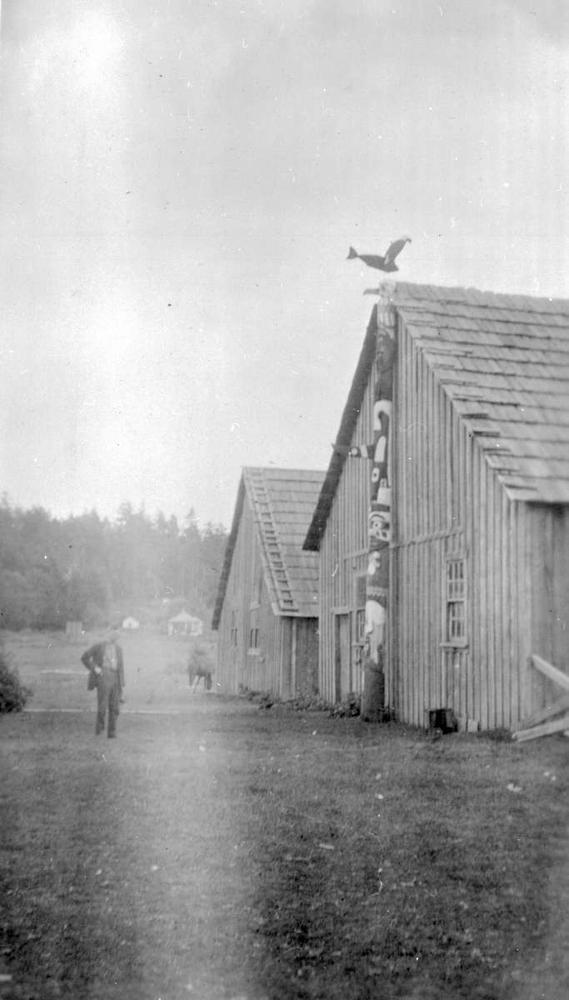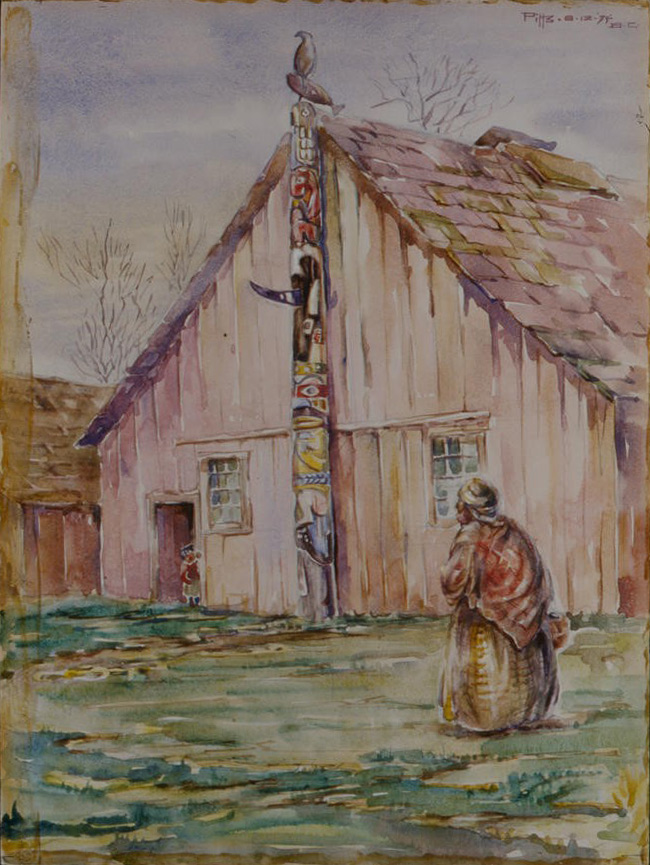Two older memorial poles, once on the New Songhees Reserve, have contradictory information about their provenience. Who carved them? One was originally owned by the Songhees Councilor William Roberts (1894-1938) and the other by the Chief Michael Cooper (1864-1936).
The William Roberts Pole
This pole is in the Royal B.C. Museum collection with two numbers. RBCM Ethnology # 5043 is the main pole, and RBCM #5051 is the eagle carving that was once on top of RBCM # 5043. It was purchased from Songhees Band member Alice James in 1940. The Report of the Provincial Museum of Natural History For the Year 1940 (1941:D14) refers to: ”By Purchase. Mrs. Alice James, Victoria. One totem-pole, 1 eagle figure”.
Songhees Band member, Alice James (nee Sam) (1874-February 1, 1963) was married to Tom James (1862-April 3, 1961). They lived on Chatham Island for many years where Tom was a fisherman. They later retired to #12 Cooper Road on the Songhees Reserve.
Information from Songhees band member Alice James: “It was made for a Songhees by William Clallam from Port Angeles in 1912. The whale spirit is that of the owner and the raven and bear the guardian spirits of the owner’s brother”.
The date of 1912 can not be true. The pole was erected on October 23, 1919. It does not appear in any of the photographs seen in the potlatch of 1912.
In 1975, Dan Savard, of the (then) RBCM Ethnology Unit, observed that, when this pole was in the breezeway cases in the exhibit building in 1975, a new and longer beak had been added, and the eagle and fish were not attached to it. The pole was mistakenly re-catalogued as RBCM17364.
There is some confusion regarding the numbering of photographs and times they were taken. Some of the images given a Charles Newcombe catalogue number, were changed to a RBCM PN (photo number). When the RBCM was in a separate Government Department from the Provincial Archives, different numbers were sometimes given for the same image or duplicate negatives were made. The B.C. Archives had their different system of referencing a photograph file number and a negative number. Since there was often found to be different versions of photographs from the same negative, it became important to use the original negative number from which they came.
The History of the photographs showing the Pole
The pole was once erected in front of a “big house” on the Songhees Reserve, owned by Songhees councilor William Robert. It was the second “Big House” from the north end of the row of five new buildings erected in 1911 (Figure 1-3). The pole was carved and erected October 23, 1919, based on the diary of Arthur Pitts. The first images of the pole on the William Robert “Big House” appear in July 1920.
- Photographs, July 1920, by Charles F. Newcombe. PN822 [Newcombe catalogue E 697 – XV/ 52a] and PN823 [Newcombe catalogue E 697 – XV/ 52b].
- Photographs in October 1920, by an unknown person. HP073428 F-02729 and HP073429 F-02730. RBCM PN822 was taken near the same time. Note direction of bird on top and presence of the beak, which is missing in RBCM PN00920 E-0727. The vegetation is the same.
- Photographs taken in July 1928, by William Arnold Newcombe – PN00920 E-0727 [Newcombe catalogue E 727-XVII/64]. In this image the beak of the bird below the eagle is missing and the eagle and fish are facing a different direction than in the 1920 images.
- Around February 1930, a group of images was probably taken by William Newcombe. Only PN 1192 [ E 811d – XVIII/ 42] is attributed to him. This image refers to “goat wool weaving on loom for Mrs. Spier, Seattle”. Others taken around the same time include a view of the back of the five, 1911 build houses, PN6840 and a front view PN5850, which shows the pole with the missing beak and, above this, the eagle on top facing the front of the houses in the same position as in the 1928 images.
- A painting of the house and pole were done by Arthur D. J. Pitts on Dec. 6, 1834, (Archive pdf 01501_141). The text with the pdf 1501 image is: “This water colour depicts a pole carved by Willie Clallam in late 1912 at the “new” Songhees reserve”. When the latter information was added is not known.
Different information, than that given by Alice (nee Sam) James about this pole, was written only a year before it was donated to the Museum. The pole was in a photograph and mentioned June 4, 1939, in The Daily Colonist. Magazine Features. Third Section, article entitled: “Canoe Making Nearly Lost Art Now”. A different photograph (not in any archives?) shows the pole with a caption that states:
“It was carved on the west coast of Vancouver Island to commemorate exploits of an Indian Known simply as “Old Sam”. He dwelt in these parts prior to 1843…”. The article is about Saanich canoe carvers and there is no indication where the newspaper writer’s information was coming from. One can speculate that this person named “Old Sam” may be a carver known as Nootka Sam. There is a death record for a man whose name is recorded as “Old Sam”. He died November 11, 1927 at age 84 in Numukamis (registration number 1927-09-011992). If, Old Sam carved the pole he would have been 76 at the time. There is a death record for a “Nootka Sam” at “Nootka” who died at age 90 in March 20,1924 (Registration number 1925-09-008646). If he caved the pole, he would be 85 at the time. Future research will be needed to examine these contradictory proveniences.




Songhees, George Cooper’s Pole
The RBCM Archives photograph, HP53376 (Neg. C-8036), shows a carved pole at the inside back of the “big house” owned in 1956, by Songhees Councilor, George Cooper.
The longhouse, located on the Maplebank part of the Songhees Reserve was built in 1911, for George’s father Chief Michael Cooper. When interviewed for an article that was in the Times Colonist (October 10,1956), entitled: “Old Potlatch House to be demolished”, George Cooper did not know the origin of the pole which he said was acquired by his father. The Colonist article shows a close-up of the pole set up against the back wall. Betty Newton, who worked as a technician at the (then) Provincial Museum took the photograph C-08036; HP53376. She found out that the “totem pole” was “won at a potlatch and made by Captain Jack (the elder), whose mother was, according to Mungo Martin, a Kwakiutl from Alert Bay”. A person known as “Captain Jack”, lived at Yuquot, on the West Coast of Vancouver Island. He was known to commission Jimmy John to make house posts for his home which are now in the Royal B.C. Museum. There is no record of Captain Jack or Jimmy John making this pole.
In the newspaper article George Copper (mistakenly referred to as “Chief”), is quoted as saying: “the Smithsonian Institution in the United State was interested in getting the pole”. Wilson Duff, then, the Curator of Anthropology at the Provincial Museum, must have seen the newspaper article and tried to arranged with George Cooper to purchase the pole.
On November 2, 1956, J.V. Boys, Indian Superintendent, Cowichan Agency, wrote to Songhees Chief Arthur Albany:
“Dear Arthur:
Mr. Wilson Duff, of the Provincial Museum, in Victoria, has approached George Cooper to purchase a totem pole in George’s big house at Maplebank. As you probably are aware, under the provisions of the Indian Act, the sale of such property cannot be undertaken without the consent of the Minister of this Department, to whom we intend to refer the matter. In order to support our submission, it would be helpful if we had a resolution of your Band Council that they are not opposed to this transaction. If you are in agreement, will you kindly have the Council sign and return the enclosed resolution” (RBCM Archives GR0111, Box 31, File 9).
The RBCM did not acquire the Cooper pole and I have not found out yet where it went.
